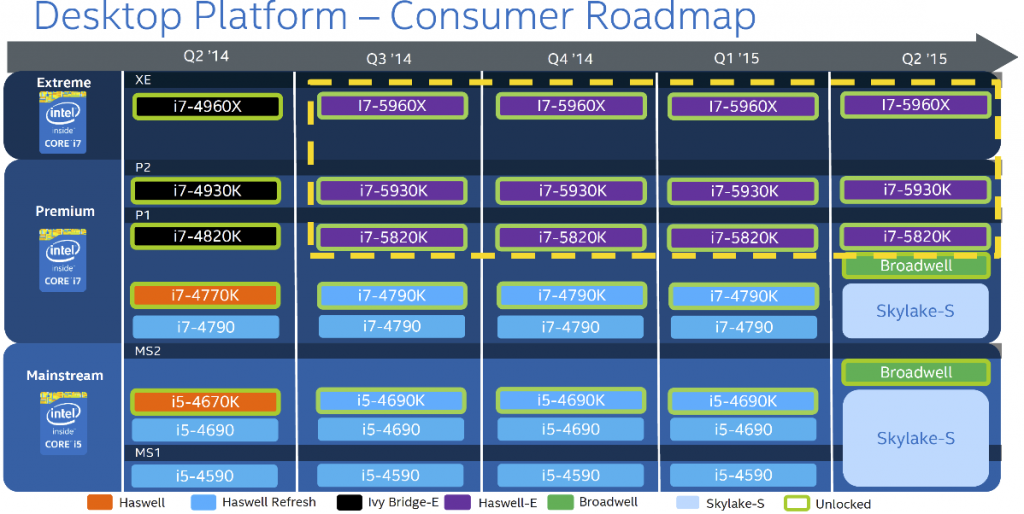Although the release of the code-named “Skylake-S” microprocessors in the second quarter of 2015 could please some users and generate additional demand for personal computers, for makers of mainboards as well as some other computer components it will create a rather huge mess.
As reported earlier, Intel Corp.’s “Skylake-S” microprocessors for desktops may emerge on the market as early as in the second quarter of 2015. The new central processing units will rely on motherboards with LGA1151 sockets powered by Intel 100-series chipsets (e.g., Z170, H170, Q170 and Q150). Since the “Skylake-S” chips support both DDR3 and DDR4 memory types, some of LGA1151 mainboards will feature 240-pin DDR3 DIMM slots, whereas other will sport 288-pin DDR4 DIMM slots.
The “Skylake-S” microprocessors will target select market segments, they will not replace anything on the market, but will complement existing offerings. As a result, in mid-2015 there will be five Intel-based platforms for desktops available: LGA1150 mainboards based on 8-series chipsets for existing “Haswell” processors, LGA1150 motherboards powered by 9-series core-logic for “Haswell” and “Broadwell” central processing units, LGA1151 mainboards featuring 100-series chipsets for “Skylake-S” chips that support either DDR3 or DDR4 and LGA2011 v3 motherboards based on the X99 core-logic for “Haswell-E” high-end desktop CPUs. It should be noted that Intel will also continue to offer entry-level all-in-one solutions based on the code-named “Bay Trail-D” and/or “Braswell” chips.
Since mainboards require different components, mechanical parts and logic sets, the complexity could create shipment and inventory challenges for manufacturers of mainboards, reports DigiTimes citing sources among makers of motherboards. Moreover, since many of Intel processors will offer similar performance and will address similar segments of the market, there will be inevitable internal competition between Intel’s own central processing units, which will create additional issues for distributors, PC makers and stores.
Intel usually advices mainboard makers in advance regarding its shipment plans and product mixes for the coming quarters. As a result, producers of motherboards can figure out the split between platforms. However, since they cannot predict exact demand from the end user, they will inevitably face certain challenges with Intel’s platforms in 2015.
Given the cut-throat competition on the market of motherboards, Intel’s decision to offer a lot of different platforms at once will likely once again lower profitability of mainboard manufacturers. Perhaps, some of them will be forced to either exit the market of merge their platform businesses in order to remain competitive in terms of pricing.
Discuss on our Facebook page, HERE.
KitGuru Says: While typically a choice is a good thing for the consumer, this does not seem to be the case right now. Many processors and platforms will offer similar levels of performance and will therefore create a lot of confusion. Moreover, in many situations it will be rather hard to make a choice. For example, Intel’s “Skylake-S” platforms will offer native SATA Express support, but will not offer overclockability (since Intel has no plans to release Skylake-K processors in Q2 2015); by contrast, Intel’s “Haswell-K” and “Broadwell-K” will offer overclockability, but will not feature native SATA Express support.
 KitGuru KitGuru.net – Tech News | Hardware News | Hardware Reviews | IOS | Mobile | Gaming | Graphics Cards
KitGuru KitGuru.net – Tech News | Hardware News | Hardware Reviews | IOS | Mobile | Gaming | Graphics Cards





Still doesn’t answer my question as to whether or not there will be unlocked cpu’s on Skylake or whether these will be low or high end products
This is why Broadwell-E got delayed until 2016 and maybe even later with all these processors on the market, like I said on Fudzilla, it’s kinda reminding me of the Nehalem days when we had six or more different kinds of processors on the market Crazy!
PhoneyVirus
https://twitter.com/PhoneyVirus
https://phoneyvirus.wordpress.com/
It seems like their gonna make us wait for Skylake-K as it will conflict w/ Broadwell-K APUs. Never settle.